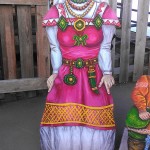The Yusupovs were a Russian noble family descended from the mogul monarchs of the Nogai Horde who, by the 18th and 19th centuries, were renowned in Russia for their immense wealth which rivaled the Romanovs. They carefully competed with the royal family in their philanthropy and art collections. Prince Felix Yusupov II was famous for his involvement in the murder of Rasputin.
The Yusupov Palace is fascinating because, up until the revolution it was lived in by powerful members of the Yusupov family. The “palace” or mansion had gone through periodic updates or remodeling which reflected changing periods and fashion and is historically informative. The publicly accessible rooms are completely furnished which for me makes them far more interesting than the royal Romanov castles and estates. The “bonus rooms” are those in the basement depicting murder of Rasputin told flamboyantly by every guide.
Historically, Khan Yusuf allied himself with Tsar Ivan the Terrible. However these former allies eventually fell out. Khan Yusuf’s daughter Sumbecca was Queen of Kazan, and when Kazan was razed by Ivan, Khan Yusuf’s daughter was taken as prisoner to Moscow.
After Khan Yusuf died, another period of hostility between his descendants and the ruling families of Russia followed until the 17th century. Finally when Abdul Mirza, yet another descendant, converted from Islam to Orthodox Christianity changing his name to Dmitry the family was accepted into mainstream society. After the conversion, Tsar Feodor I bestowed upon Dmitry the title of Prince Yusupov .
The last Yusupov Prince was Prince Felix Yusupov II, Count Sumarokov-Elston, the younger son of Zinaida and Felix Sumarokov-Elston, who is famous for his involvement in the murder of Gregory Rasputin. Felix Yusupov II married Princess Irina, niece of the last Russian Tsar, Nicholas II. After the murder of Rasputin he was exiled to Crimea, but returned to St. Petersburg in 1917
In April 1919, he left Russia for good for Paris taking his most precious paintings by Rembrandt as week as family jewels. He was the last Yusupov prince. His daughter, Irina, married Count Sheremetev’s descendant. They moved to Greece with their children, although recently they were granted Russian citizenship by the Russian President and Irina consults with St. Petersburg Museums about her family’s history and estates. She has no property rights in Russia today.

























